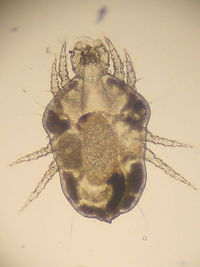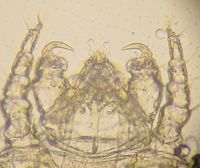Cheyletiella spp.
| Cheyletiella | |
|---|---|
| Phylum | Arthropoda |
| Class | Arachnida |
| Order | Trombidiformes |
| Family | Cheyletidae |
| Genus | Cheyletiella |
Introduction
Cheyletiella mites are surface mites of dogs and cats. They are also found on humans and rabbits. They cause Cheyletiellosis, a parasitic skin infestation.
Identification
They have a waisted body and claw like palps on their heads. They also have combs at the ends of their legs.
Lifecycle
The lifecycle of a Cheyletiella mite lasts 21-35 days on the host. The adults mites can survive off the host for 2-14 days. They live on the skin surface and their eggs are attached to hair shafts.
Pathogenesis
The mites are highly contagious and cause mild pathogenesis. They are seen to cause very scaly dermatitis. Cheyletiella mites can be transferred to humans.
Important Species
C.yasguri- Most commonly found on dogs.
C.blakei- Most commonly found on cats and humans.
C.parasitivorax- Most commonly found on rabbits.
| Cheyletiella spp. Learning Resources | |
|---|---|
 Test your knowledge using flashcard type questions |
Mites Flashcards Small Mammals Q&A 13 |
References
Taylor, M.A, Coop, R.L., Wall,R.L. (2007) Veterinary Parasitology Blackwell Publishing

